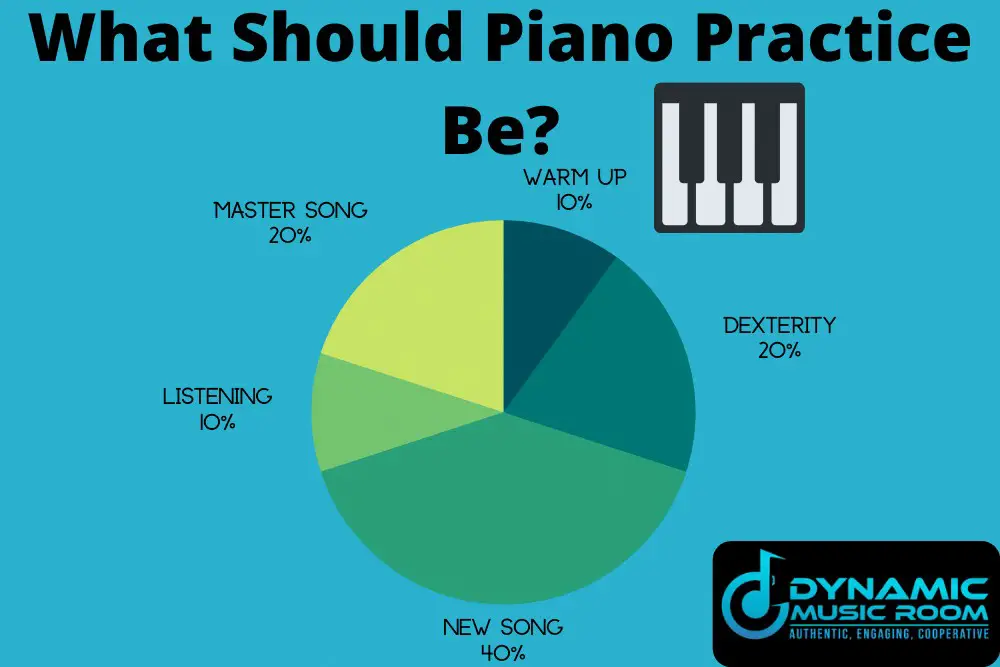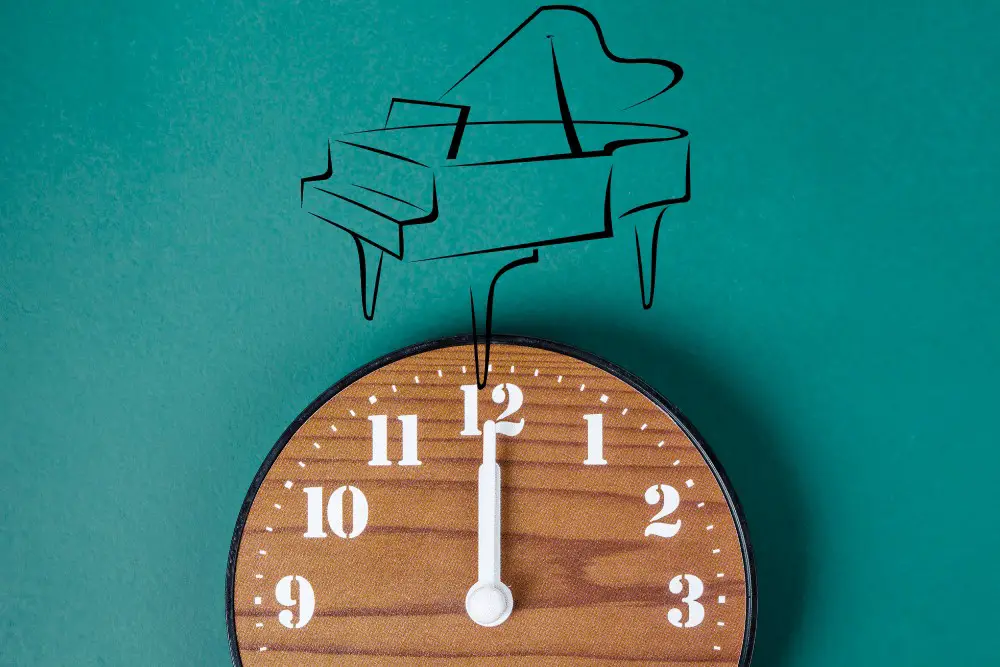Do you want to get better at the piano?
Are you confused as to what you should be practicing?
Learning piano is great and all, but I’ve seen student after student confused on how to get better.
This is why as a music teacher, I know it’s critical to teach players how to practice piano instead of simply giving them an assigned amount of time to practice.
When practicing piano, split your time into different areas. This should include warm up, dexterity practice (scales and arpeggios), new song practice, listening, and master song practice.
Let’s dig into the details below.
Table of Contents
How To Practice Piano: Detailed Breakdown
In this section, we’ll answer many questions related to practicing piano.
Follow all the tips and elements in this guide, and you’ll be amazed at how quickly you improve over time.
Learn how long it takes to get good at the piano.
How Often Should I Practice Piano?
The most obvious answer to this question is: every day!
But in reality, we know this won’t work.
In fact, an everyday attitude will end up hurting your desire to practice.
If you set a goal to practice every single day, you will fail.
At some point, you’ll miss a day. It will happen. Life happens!
But if you set a goal to practice every single day and you miss one, now that missed day becomes a failure.
Once you feel like a failure, it’s a slippery slope to quitting your practice altogether.
This is why I recommend you set a goal to practice 5 days per week.
Missing a day or two per week isn’t crucial, but it gives you some leeway in your schedule.
Of course, you should always listen to your piano teacher, but give yourself some forgiveness.
Even the pros don’t practice every single day. They take breaks too.
But you need to hold yourself to this number of 5 until practicing becomes a habit.
Then, it’s something you just do, not something you have to do.
How Long Should A Practice Session Be?
When looking at how long a practice session should be, the answer varies.
If you want to improve quickly, more practice equals more improvement.
To a certain point.
There is such a thing as too much practice.
For new players, I recommend at least 20 minutes for each session.
It may seem short, and you’re free to go longer, but new players don’t have the practice stamina to go for long periods productively.
You want to enjoy your time with the piano, right?
Over a few weeks, increase your time to 45 minutes.
For most people, they should top out here.
Serious players may want to go for more, but I wouldn’t do more than 3 hours per day at the most.
This is only for people following music as a career.
For the record, this is what I ended up practicing for most of my time in my undergrad.
Of course, I still only practiced 5 days per week. It’s important to have boundaries with your practice schedule.

What Should A Practice Routine Consist Of?
We’ve talked about how often and how long practice time is.
Now let’s talk about what the focus of the session should be.
Is it just mastering the notes of a new song?
Is it study of the sheet music and playing along with a metronome for hours?
No.
I break all sessions into these 5 chunks.
However long your time is, split it up into something like this:
- 10% Warmup
- 20% Dexterity
- 40% New Song
- 10% Listening
- 20% Master Song
Spending all your time on one thing is a common mistake.
Follow these ideas will help you avoid developing bad habits for practicing.
1. Warm Up
The first chunk of time is the warm up.
There are different routines out there, and many of them include the next chunk as well.
I consider them as different chunks because the next one should be more intentional.
The warmup should be:
- Simple
- Enjoyable
- Get the blood flowing to the fingers
- Involve slow practice
- Start with hands moving together and then hands separate
A warm up may be an etude based on a series of scales or arpeggios, or it may an easy, light song you already know.
The focus of a warm up should be on the ideas above.
2. Dexterity – Scales, Arpeggios, Etudes, Etc.
Next up is an area most pianists either do too much or too little of, in my experience.
Here the piano practice needs to focus on scales and arpeggios exercises especially.
Which ones you need to practice depend completely on your ability level, but if you follow a book series, they’re usually good at helping you figure out what you need to practice.
Check out the Piano Scales, Chords, and Arpeggios for help in this regard.
Turn a metronome on at a slow tempo and go through each exercise multiple times.
Every time you play it correctly, speed up the metronome 5-10 clicks until you can’t anymore.
Then move onto the next one at a slow tempo again.
This will build the muscle memory you need when you see these patterns as they appear in the sheet music of real songs.
This is the essence of piano technique.
Remember, this is where you have some slow practice that builds up.
Don’t go crazy fast right off the bat, no matter how familiar you are with it.
Too little of this hurts your piano playing and technical skills in the long run.
Too much, though, will slow down what songs you know.
3. New Song
The bulk of your time, and rightfully so, should be spent on learning and mastering new material.
You should have a piece or multiple pieces you’re in the process of learning.
Here we want to break down the difficult parts of the pieces and then rebuild them back into the entire piece (if time allows).
A piano teacher will help you find the right pieces you’re ready for.
Barring that, you may wish to follow a proven program or book (check out our must-have resources below).
Here, I will mention that I’ve found no greater online program for piano than Flowkey.
Its massive song list and learning tools are perfect for practicing and mastering new songs.
For experienced players (usually after a year of practice), I encourage pianists to spend a small chunk of this time also doing sight-reading practice.
Sight-reading is when you play a song on seeing it the first time.
4. Listening
I rarely see most piano teachers talk about this, and I believe it holds their students back.
Time must be spent on listening to piano music and great piano performers.
I’m not talking about simply listening while walking.
I want you to focus on the emotion of how they play.
If a video is available, watch the person play.
This will improve your own understanding of what it means to perform the music.
If at all possible, listen to professionals perform the songs you’re learning and follow along with the sheet music as well.
5. Master Song
This is where I encourage piano players to end by playing something they love to play and they play well.
This may be easy or challenging.
The point is that you enjoy it.
Too often, a practice session will end on a tough part with an unhappy or frustrated musician.
It’s important to like what you do, so stopping by playing something you like keeps you motivated to come back again tomorrow.
15 General Piano Practice Tips
Here are some general piano practice tips you may want to keep in mind as you go about improving your skills.
- Always warm up, your fingers will thank you.
- Practice more often for shorter periods if you don’t have hours to spend practicing.
- 10-15 minute practice sessions multiple times per day are good too.
- Practice slowly and then move quickly.
- Don’t always start at the beginning of your piece.
- When in doubt, practice one hand at a time.
- You should enjoy what you’re playing.
- Listen to the piano often.
- Avoid going three days without practicing if at all possible.
- Practice fingering exercises without a piano when you have spare time.
- Long practice sessions (over an hour) aren’t always useful.
- Don’t spend all your time on things you already know.
- Learn the right fingerings; don’t invent your own way.
- Don’t stare at your hands; learn to feel where the notes are without looking.
- Always use a metronome where it applies (which is pretty much everywhere).
Must-Have Piano Practice Resources
Here are a few of the resources I consider “must-haves” for practicing piano.
Consider adding these to your toolbox. Trust me, they’re worth it.
Disclosure: Links may be affiliate in nature, which means we earn a small commission at no extra cost to you. However, we don’t recommend products we don’t believe in.
Metronome: You NEED to have a metronome.
A good one like the Korg metronome takes your practice to the next level, though the free ones you’ll find online will do the job too.
But the extra features of a dedicated metronome like the one by clicking the button below.
Repertoire: Of course, you need real songs to practice.
I can’t believe how many songs (literal 1,000s) Flowkey has.
From Classical to Jazz to Pop, it has almost everything imaginable.
Not only that, the quality recordings and sheet music also come with a whole host of learning tools.
Exercises: To cover the etudes and dexterity exercises, you’ll need an exercise book.
I linked to one in the earlier section, so check that out if you’re looking for one.
Flowkey also has a ton of exercises and mini-courses on technical playing too.
It’s basically a one-stop-shop for everything you may need.
You may also want to check out the best books for intermediate piano players.
Final Thoughts
I hope this guide on how to practice piano helps you.
Remember, half the battle is making practice an ingrained habit, so it’s not a matter of how much you need to practice, but it’s just something you do.
After this, vary your practicing into skill-building and mastering parts.
Over time, it pays off and you’ll be amazed at how you turn from a student to a real pianist.

